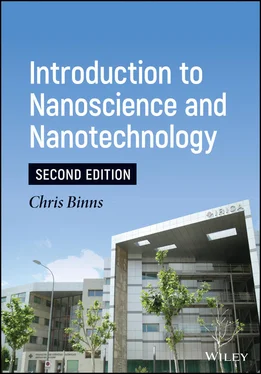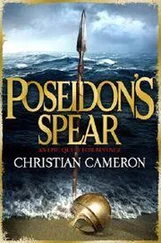4 4 An HIV virus with a diameter of 100 nm has 50 glycoprotein extrusions over its surface, each one of which will bind a 5 nm diameter Ag nanoparticle. You are provided with a suspension of 5 nm diameter Ag nanoparticles containing 1 μg Ag per milliliter of liquid. What volume of the suspension is required to saturate 107 viruses in a test tube?
1 1 Upward, M.D., Moriarty, P., Beton, P.H. et al. (1997). Measurement & manipulation of Mn clusters on clean and fullerene terminated Si(111)‐7×7. Applied Physics Letters 70: 2114. https://doi.org/10.1063/1.118965.
2 2 Schüler, D. (2002). The biomineralisation of magnetosomes in Magnetospirillium gryphiswaldense. International Microbiology5: 209–214. https://doi.org/10.1007/s10123‐002‐0086‐8.
3 3 McKay, D.S., Gibson, E.K. Jr., Thomas‐Keprta, K.L. et al. (1996). Search for past life on mars: possible relic biogenic activity in Martian meteorite ALH84001. Science 273: 924–930. https://doi.org/10.1126/science.273.5277.924.
4 4 Billas, I.M.L., Chatalain, A., and de Heer, W.A. (1994). Magnetism from the atom to the bulk in iron, cobalt, and nickel clusters. Science 265: 1682. https://doi.org/10.1126/science.265.5179.1682.
5 5 Cox, A.J., Louderback, J.G., Apsel, S.E., and Bloomfield, L.A. (1994). Magnetism in 4d‐transition metal clusters. Physical Review B 49: 12295–12298. https://doi.org/10.1103/PhysRevB.49.12295.
6 6 Apsel, S.E., Emmert, J.W., Deng, J., and Bloomfield, L.A. (1996). Surface‐enhanced magnetism in nickel clusters. Physical Review Letters 76: 1441–1444.
7 7 Knickelbein, M.B. (2002). Adsorbate‐induced enhancement of the magnetic moments of iron clusters. Chemical Physics Letters 19: 221–225. https://doi.org/10.1016/S0009‐2614(02)00024‐6.
8 8 Payne, F.W., Jiang, W., Emmert, J.W. et al. (2007). Magnetic structure of free cobalt clusters studied with Stern‐Gerlach deflection experiments. Physical Review B 75: 094431. https://doi.org/10.1103/PhysRevB.75.094431.
9 9 Baker, S.H., Binns, C., Edmonds, K.W. et al. (2002). Enhancements in magnetic moments of exposed and Co‐coated Fe nanoclusters as a function of cluster size. Journal of Magnetism and Magnetic Materials 247: 19–25. https://doi.org/10.1016/S0304‐8853(02)00090‐2.
10 10 Upward, M.D., Cotier, B.N., Moriarty, P. et al. (2000). Deposition of Fe clusters on Si surfaces. Journal of Vacuum Science & Technology B 18: 2646–2949. https://doi.org/10.1116/1.1320808.
11 11 Binns, C., Trohidou, K.N., Bansmann, J. et al. (2005). The behaviour of nanostructured magnetic materials produced by depositing gas‐phase nanoparticles. Journal of Physics D: Applied Physics 38: R1–R23. https://doi.org/10.1088/0022‐3727/38/22/R01.
12 12 Hall, E.O. (1951). The deformation and ageing of mild steel: III Discussion of results. Proceedings of the Physical Society. Section B 64: 747–753. https://doi.org/10.1088/0370‐1301/64/9/303.
13 13 Petch, N.J. (1953). Journal of Iron and Steel Institute 174: 28–38.
14 14 Youssef, K.M., Scattergood, R.O., Murty, K.L., and Koch, C.C. (2006). Nanocrystalline Al–Mg alloy with ultrahigh strength and good ductility. Scripta Materialia 54: 251–256. https://doi.org/10.1016/j.scriptamat.2005.09.028.
15 15 Koch, C.C., Youssef, K.M., Scattergood, R.O., and Murty, K.L. (2005). Breakthroughs in optimization of mechanical properties of nanostructured metals and alloys. Advanced Engineering Materials 7: 787–794. https://doi.org/10.1002/adem.200500094.
16 16 Lopez, N., Janssens, T.V.W., Clausen, B.S. et al. (2004). On the origin of the catalytic activity of gold nanoparticles for low‐temperature CO oxidation. Journal of Catalysis 223: 232–235. https://doi.org/10.1016/j.jcat.2004.01.001.
17 17 CDC (2019). Antibiotic resistance threats in the United States, 2019. Atlanta, GA: U.S. Department of Health and Human Services, CDC. https://www.cdc.gov/drugresistance/pdf/threats‐report/2019‐ar‐threats‐report‐508.pdf.
18 18 Castellano, J.C., Shafi, S.M., Ko, F. et al. (2007). Comparative evaluation of silver‐containing antimicrobial dressings and drugs. International Wound Journal 4: 114–122. https://doi.org/10.1111/j.1742‐481X.2007.00316.x.
19 19 Morones, J.R., Elechiguerra, J.L., Camacho, A. et al. (2005). The bactericidal effect of silver nanoparticles. Nanotechnology 16: 2346–2353. https://doi.org/10.1088/0957‐4484/16/10/059.
20 20 Elechiguerra, J.L., Burt, J.L., Morones, J.R. et al. (2005). Interaction of silver nanoparticles with HIV‐1. Journal of Nanobiotechnology 3: 1–10. https://doi.org/10.1186/1477‐3155‐3‐6.
21 21 Rai, M., Deshmukh, S.D., Ingle, A.P. et al. (2014). Metal nanoparticles: the protective nanoshield against virus infection. Critical Reviews in Microbiology 42: 46–56. https://doi.org/10.3109/1040841X.2013.879849.
22 22 Haggag, E.G., Elshamy, A.M., Rabeh, M.A. et al. (2019). Antiviral potential of green synthesized silver nanoparticles of Lampranthus coccineus and Malephora lutea. International Journal of Nanomedicine 14: 6217–6229. https://doi.org/10.2147/IJN.S214171.
1 1Magnetic moment or magnetic dipole moment, denoted by the symbol μ, summarizes the characteristics of a simple loop of current, producing a magnetic field, by the equation μ = IA, where I is the circulating current and A is the area enclosed by the loop. A simple loop such as this produces a dipolar magnetic field similar to that produced by a bar magnet with north and south poles.
2 2Magnetostatic energy is the energy of a permanent magnet interacting with a static magnetic field.
3 3A Bohr magneton (1μB) is the magnetic moment of a single free electron produced by its intrinsic angular momentum (spin).
4 4The high magnetization was first observed in Fe67Co33 alloys, but the magnetically soft variant Fe50Co50 that is used commercially was patented in 1929 by G. W. Elmer.
5 5Bacterium that infects the lungs of cystic fibrosis sufferers and causes inflammation and breathing problems.
6 6You should find that your estimate is much larger than the critical size (~100 nm) for a single‐domain particle given in the text. The reason is that the exchange energy in a domain boundary can be reduced by a large factor by spreading it over a number of atomic layers. That is, instead of having an abrupt 180ª reversal of the magnetization across a single atomic plane, the magnetization rotates a fraction of 180° across each plane. This brings the critical size down to ~100 nm.
2 Nanoparticles and the Environment
In the previous chapter, the special properties of matter at nanoscale dimensions were presented and how this novel behavior could be exploited in technologies as diverse as advanced engineering materials and health care. This chapter is about nanoparticles and the environment, which encompasses naturally occurring nanoparticles and environmental applications of nanotechnology. Sections 2.1– 2.7discuss naturally occurring nanoparticles, both in our immediate environment, that is, the Earth's crust, oceans and atmosphere and out into deep space, where nanoparticles with their unique properties have helped shape the observable Universe. Section 2.7describes the use of nanoparticles in addressing environmental issues via two important examples, that is, removing toxins from groundwater and recycling plastics.
2.1 Nanoparticles in the Atmosphere
The particles in the Earth's atmosphere have an important influence on the climate, but also have a poorly understood effect on life and our health. Improving our understanding of the effect of airborne nanoparticles is becoming increasingly important in a world where nanotechnology is poised to become a major activity. Clearly, the amount of manufactured nanoparticles will increase, so it is wise to be aware of how they interact with life and with the environment. It is important to emphasize, however, that manufactured nanoparticles are normally bound up in some material and the number of “loose” particles produced by nanotechnology will not necessarily become significant compared to those produced by the natural processes described below. In this chapter, the discussion is extended to encompass nanoparticles that are generated by existing human activities not directly involving nanotechnology, such as power generation, transport, etc. Obviously, these are not naturally occurring in the normal sense of the phrase, but they are a component of a pre‐nanotechnology background of nanoparticles in which we live. The effect of naturally occurring nanoparticles on the environment is an enormous multidisciplinary subject and a rigorous discussion is well beyond the scope of this book. It is an important hot topic, however, as it encompasses climate change and nanoparticles are implicated in many of the feedback mechanisms involved in the Gaia hypothesis that treats the Earth as a living organism. The aim of this chapter is to describe, in general terms, where the nanoparticles come from and, as in the previous chapter, emphasize the special nature of particles belonging to the nanoworld (<100 nm – Figure I.1).
Читать дальше












